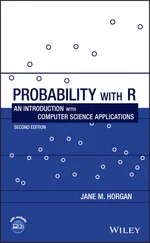The rights of Amy S. Wagaman and Robert P. Dobrow to be identified as the authors of this work has been asserted in accordance with law.
Registered Office John Wiley & Sons, Inc., 111 River Street, Hoboken, NJ 07030, USA
Editorial Office 111 River Street, Hoboken, NJ 07030, USA
For details of our global editorial offices, customer services, and more information about Wiley products visit us at www.wiley.com.
Wiley also publishes its books in a variety of electronic formats and by print-on-demand. Some content that appears in standard print versions of this book may not be available in other formats.
Limit of Liability/Disclaimer of Warranty
The contents of this work are intended to further general scientific research, understanding, and discussion only and are not intended and should not be relied upon as recommending or promoting scientific method, diagnosis, or treatment by physicians for any particular patient. In view of ongoing research, equipment modifications, changes in governmental regulations, and the constant flow of information relating to the use of medicines, equipment, and devices, the reader is urged to review and evaluate the information provided in the package insert or instructions for each medicine, equipment, or device for, among other things, any changes in the instructions or indication of usage and for added warnings and precautions. While the publisher and authors have used their best efforts in preparing this work, they make no representations or warranties with respect to the accuracy or completeness of the contents of this work and specifically disclaim all warranties, including without limitation any implied warranties of merchantability or fitness for a particular purpose. No warranty may be created or extended by sales representatives, written sales materials or promotional statements for this work. The fact that an organization, website, or product is referred to in this work as a citation and/or potential source of further information does not mean that the publisher and authors endorse the information or services the organization, website, or product may provide or recommendations it may make. This work is sold with the understanding that the publisher is not engaged in rendering professional services. The advice and strategies contained herein may not be suitable for your situation. You should consult with a specialist where appropriate. Further, readers should be aware that websites listed in this work may have changed or disappeared between when this work was written and when it is read. Neither the publisher nor authors shall be liable for any loss of profit or any other commercial damages, including but not limited to special, incidental, consequential, or other damages.
Library of Congress Cataloging-in-Publication Data
Names: Wagaman, Amy Shepherd, 1982- author. | Dobrow, Robert P., author.
Title: Probability : with applications and R / Amy S. Wagaman, Department of Mathematics and Statistics, Amherst College, Amherst, MA, Robert P. Dobrow, Department of Mathematics, Carleton College, Northfield, MN.
Description: Second edition. | Hoboken, NJ : Wiley, [2021] | Includes bibliographical references and index.
Identifiers: LCCN 2021007900 (print) | LCCN 2021007901 (ebook) | ISBN 9781119692386 (cloth) | ISBN 9781119692348 (adobe pdf) | ISBN 9781119692416 (epub)
Subjects: LCSH: Probabilities–Data processing. | R (Computer program language)
Classification: LCC QA276.45.R3 D63 2021 (print) | LCC QA276.45.R3 (ebook) | DDC 519.20285/5133–dc23
LC record available at https://lccn.loc.gov/2021007900
LC ebook record available at https://lccn.loc.gov/2021007901
Cover Design: Wiley
Cover Image: © D3Damon/Getty Images, NicoElNino/Shutterstock
Amy: To my fantastic, supportive fiancé, Stephen,my beloved parents (rest in peace, Mom), and my Aunt Pat
Bob: To my wonderful familyAngel, Joe, Danny, Tom
Probability: With Applications and R is a probability textbook for undergraduates. The second edition contains modest changes from the first, including some reorganization of material. It assumes knowledge of differential and integral calculus (two semesters of calculus, rather than three semesters). Double integrals are introduced to work with joint distributions in the continuous case, with instruction in working with them provided in an appendix. While the material in this book stands on its own as a “terminal” course, it also prepares students planning to take upper level courses in statistics, stochastic processes, and actuarial sciences.
There are several excellent probability textbooks available at the undergraduate level, and we are indebted to many, starting with the classic Introduction to Probability Theory and Its Applications by William Feller.
Our approach is tailored to our students and based on the experience of teaching probability at a liberal arts college. Our students are not only math majors but come from disciplines throughout the natural and social sciences, especially biology, physics, computer science, and economics. Sometimes we will even get a philosophy, English, or arts history major. They tend to be sophomores and juniors. These students love to see connections with “real-life” problems, with applications that are “cool” and compelling. They are fairly computer literate. Their mathematical coursework may not be extensive, but they like problem solving and they respond well to the many games, simulations, paradoxes, and challenges that the subject offers.
Several features of our textbook set it apart from others. First is the emphasis on simulation. We find that the use of simulation, both with “hands-on” activities in the classroom and with the computer, is an invaluable tool for teaching probability. We use the free software Rand provide supplemental resources (on the text website) for getting students up to speed in using and understanding the language. We recommend that students work through the introductory Rsupplement, and encourage use of the other supplements that enhance the code and discussion from the textbook with additional practice. The book is not meant to be an instruction manual in R; we do not teach programming. But the book does have numerous examples where a theoretical concept or exact calculation is reinforced by a computer simulation. The Rlanguage offers simple commands for generating samples from probability distributions. The book references numerous Rscript files, that are available for download, and are contained in the Rsupplements, also available for download from the text website. It also includes many short R“one-liners” that are easily shown in the classroom and that students can quickly and easily duplicate on their computer. Throughout the book are numerous “ R” display boxes that contain these code and scripts. Students and instructors may use the supplements and scripts to run the book code without having to retype it themselves. The supplements also include more detail on some examples and questions for further practice.
In addition to simulation, another emphasis of the book is on applications. We try to motivate the use of probability throughout the sciences and find examples from subjects as diverse as homelessness, genetics, meteorology, and cryptography. At the same time, the book does not forget its roots, and there are many classical chestnuts like the problem of points, Buffon's needle, coupon collecting, and Montmort's problem of coincidences. Within the context of the examples, when male and female are referred to (such as in the example on colorblindness affecting males more than females), we note that this refers to biological sex, not gender identity. As such, we use the term “sex” not “gender” in the text.
Читать дальше












